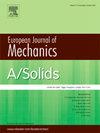全场测量非局部损伤模型的校正:在离散元场中的应用
IF 4.4
2区 工程技术
Q1 MECHANICS
引用次数: 0
摘要
连续损伤模型越来越多地用于结构的数值模拟设计,但其局部公式对网格尺寸很敏感,并且在无限薄的区域内存在应变的局部化。为了克服这些问题,已经开发了非局部损伤模型和相关的正则化方法,引入了特征/内部长度,从而避免了病态网格依赖。这些方法使得损伤演化依赖于当前材料点(局部)及其邻域(非局部)的力学量。现有的校准内部长度的方法在校准过程中使用全局量,尽管现在可以获得局部数据(例如,使用数字图像相关)。在这项研究中,我们研究了全场位移测量的使用,提出了一种基于局部场测量的非局部损伤模型校准的新方法,并将其应用于从测量的应变和损伤场校准Eikonal非局部梯度(ENL-G)方法。在详细介绍了校准过程之后,我们将其应用于一个简单的理想情况。我们从演化规律的选择和所提出的校准方法的测量噪声方面说明并分析了校准过程的鲁棒性。为了使这一过程更符合实际情况,我们采用了二维光束-粒子模型。该离散模型首先根据文献中可用的一个综合实验数据集来确定大小和形状效应,其中包括四种形状,每种形状有三种尺寸。然后,用它来生成不同尺寸梁在单轴拉伸作用下的损伤场和应变场的“参考”演化。所使用的离散模型的参数已经过校准,以表示规模和尺寸效应,从而很好地表示了实验。我们还使用Green函数说明了Eikonal方法中非局部相互作用的演变。最后,应用该校正程序可以确定所研究的非局部问题的内部长度以及损伤演化规律及其参数。本研究的结果为基于全场测量的非局部损伤模型识别提供了新的方法,并呼吁进行带位移场的尺寸效应实验研究。本文章由计算机程序翻译,如有差异,请以英文原文为准。
Calibration of non-local damage models from full-field measurements: Application to discrete element fields
Continuous damage models are increasingly used in numerical simulations to design structures, but their local formulations are sensitive to mesh size and present localization of strains in an infinitely thin region. To overcome these problems non-local damage models and related regularization methods, have been developed introducing a characteristic/internal length, thus avoiding pathological mesh dependence. Those methods make the damage evolution depends on the mechanical quantities at the current material point (local) and its neighborhood (non-local).
Existing approaches to calibrate the internal length use global quantities in the calibration process, although local data is now becoming accessible (e.g., using digital image correlation). In this study, we investigate the use of full-field displacement measurements an propose a new methodology for calibrating a non-local damage model based on local field measurements and we apply it to calibrate the Eikonal Non-local Gradient (ENL-G) approach from the measured strain and damage field. After detailing the calibration procedure, we then apply it on a simple ideal case. We illustrate, and analyze the robustness of the calibration procedure with respect to the choice of evolution law and measurement noise of the proposed calibration method. To confront the procedure to a more realistic case, we employed a 2D beam-particle model. This discrete model is first identified with respect to the size and shape effect based on one of the comprehensive experimental data sets available in the literature, including four shapes with three sizes each. Then, it is used to generate a “reference” evolution of the damage and strain fields in beams of different sizes subjected to uniaxial tension.
The parameters of the discrete model used have been calibrated to represent the scale and size effects, giving a very good representation of the experiments. We also illustrate the evolution of non-local interactions in the Eikonal approach using Green functions. Finally, the application of the calibration procedure shows that it is possible to determine the internal length of the non-local problem studied as well as the damage evolution law and its parameters. The outcomes of this study contribute to shed light on a new methodology to identify non-local damage models based on full-field measurements, and call for experimental size effect campaign with displacement field.
求助全文
通过发布文献求助,成功后即可免费获取论文全文。
去求助
来源期刊
CiteScore
7.00
自引率
7.30%
发文量
275
审稿时长
48 days
期刊介绍:
The European Journal of Mechanics endash; A/Solids continues to publish articles in English in all areas of Solid Mechanics from the physical and mathematical basis to materials engineering, technological applications and methods of modern computational mechanics, both pure and applied research.

 求助内容:
求助内容: 应助结果提醒方式:
应助结果提醒方式:


